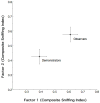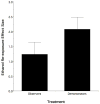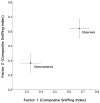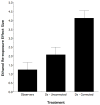The interaction of gestational and postnatal ethanol experience on the adolescent and adult odor-mediated responses to ethanol in observer and demonstrator rats
- PMID: 20608909
- PMCID: PMC2950905
- DOI: 10.1111/j.1530-0277.2010.01257.x
The interaction of gestational and postnatal ethanol experience on the adolescent and adult odor-mediated responses to ethanol in observer and demonstrator rats
Abstract
Background: Gestational ethanol exposure enhances the adolescent reflexive sniffing response to ethanol odor. Postnatal exposures of naïve animals as either an observer (i.e., conspecific) or demonstrator (i.e., intoxicated peer) using a social transmission of food odor preference paradigm also yields enhanced odor-mediated responses. Studies on the interaction of fetal and postnatal exposures using the social transmission paradigm have been limited to the responses of observers. When combined, the enhanced response is greater than either form of exposure alone and, in observer females, yields adult persistence. The absence of a male effect is noteworthy, given that chemosensory mechanisms are suggested to be an important antecedent factor in the progression of ethanol preference. Observers gain odor information on the breath of the demonstrator through social interaction. Demonstrators experience the pharmacologic properties of ethanol along with retronasal and hematogenic olfaction. Thus, we tested whether augmentation of the fetal ethanol-induced behavioral response with postnatal exposure as a demonstrator differed from that as an observer. We also examined whether re-exposure as a demonstrator yields persistence in both sexes.
Methods: Pregnant dams were fed an ethanol containing or control liquid diet throughout gestation. Progeny received four ethanol or water exposures: one every 48 hours through either intragastric infusion or social interaction with the infused peer beginning on P29. The reflexive behavioral sniffing response to ethanol odor was tested at postnatal (P) day 37 or P90, using whole-body plethysmography.
Results: When tested in either adolescence or adulthood - fetal ethanol exposed adolescent ethanol observers and demonstrators significantly differed in their odor-mediated response to ethanol odor both between themselves and from their respective water controls. Nonetheless, adolescent ethanol re-exposure as a demonstrator, like an observer, enhanced the reflexive sniffing response to ethanol odor at both testing ages by augmenting the known effects of prior fetal ethanol experience. At each age, the magnitude of the enhanced odor response in demonstrators was similar to that of observers. Interestingly, only re-exposure as a demonstrator resulted in persistence of the behavioral response into adulthood in both sexes.
Conclusions: The method of ethanol re-exposure plays an important role in prolonging the odor-mediated effects of fetal exposure. While ethanol odor-specific exposure through social interaction is important, additional factors such as the pairing of retronasal and hematogenic olfaction with ethanol's intoxicating properties appear necessary to achieve persistence in both sexes.
Copyright © 2010 by the Research Society on Alcoholism.
Figures






Similar articles
-
The Interaction of Ethanol Ingestion and Social Interaction with an Intoxicated Peer on the Odor-Mediated Response to the Drug in Adolescent Rats.Alcohol Clin Exp Res. 2016 Apr;40(4):734-42. doi: 10.1111/acer.13009. Epub 2016 Mar 20. Alcohol Clin Exp Res. 2016. PMID: 26996455 Free PMC article.
-
Adolescent ethanol experience alters immediate and long-term behavioral responses to ethanol odor in observer and demonstrator rats.Behav Brain Funct. 2009 Jun 4;5:23. doi: 10.1186/1744-9081-5-23. Behav Brain Funct. 2009. PMID: 19497110 Free PMC article.
-
The consequence of fetal ethanol exposure and adolescent odor re-exposure on the response to ethanol odor in adolescent and adult rats.Behav Brain Funct. 2009 Jan 15;5:3. doi: 10.1186/1744-9081-5-3. Behav Brain Funct. 2009. PMID: 19146665 Free PMC article.
-
Fetal or infantile exposure to ethanol promotes ethanol ingestion in adolescence and adulthood: a theoretical review.Alcohol Clin Exp Res. 2005 Jun;29(6):909-29. doi: 10.1097/01.alc.0000171046.78556.66. Alcohol Clin Exp Res. 2005. PMID: 15976517 Review.
-
From whom do animals learn? A meta-analysis on model-based social learning.Psychon Bull Rev. 2023 Jun;30(3):863-881. doi: 10.3758/s13423-022-02236-4. Epub 2023 Jan 6. Psychon Bull Rev. 2023. PMID: 36609963 Review.
Cited by
-
Fetal Alcohol Programming of Subsequent Alcohol Affinity: A Review Based on Preclinical, Clinical and Epidemiological Studies.Front Behav Neurosci. 2020 Mar 10;14:33. doi: 10.3389/fnbeh.2020.00033. eCollection 2020. Front Behav Neurosci. 2020. PMID: 32210775 Free PMC article. Review.
-
The Interaction of Ethanol Ingestion and Social Interaction with an Intoxicated Peer on the Odor-Mediated Response to the Drug in Adolescent Rats.Alcohol Clin Exp Res. 2016 Apr;40(4):734-42. doi: 10.1111/acer.13009. Epub 2016 Mar 20. Alcohol Clin Exp Res. 2016. PMID: 26996455 Free PMC article.
References
-
- Alati R, Al Mamum A, Williams GM, O’Callagham M, Najman JM, Bor W. In utero alcohol exposure and prediction of alcohol disorders in early adulthood: a birth cohort study. Arch Gen Psychiatry. 2006;63:1009–1016. - PubMed
-
- Baer JS, Barr HM, Bookstein FL, Sampson PD, Streissguth AP. Prenatal alcohol exposure and family history of alcoholism in the etiology of adolescent alcohol problems. J Stud Alcohol. 1998;59:533–543. - PubMed
-
- Baer JS, Sampson PD, Barr HM, Connor PD, Streissguth AP. A 21-year longitudinal analysis of the effects of prenatal alcohol exposure on young adult drinking. Arch Gen Psychiatry. 2003;60:377–385. - PubMed
-
- Chotro MC, Arias C, Laviola G. Increased ethanol intake after prenatal ethanol exposure: studies with animals. Neurosci Biobehav Rev. 2007;31:181–191. - PubMed
Publication types
MeSH terms
Substances
Grants and funding
LinkOut - more resources
Full Text Sources

